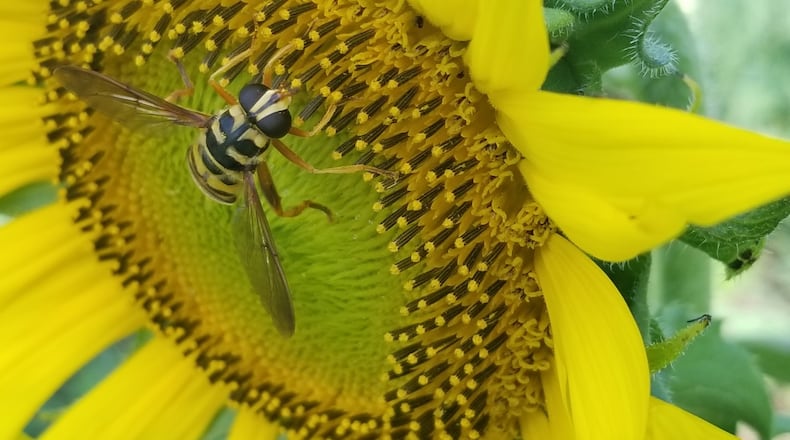We’re all busy as bees these days, but if you can carve out just 15 minutes on Aug. 18 or 19, you can be a citizen scientist and help entomology researchers in the region.
It’s time for the Great Southeast Pollinator Census. The event, now in its fifth year, is open to anyone in Georgia, South Carolina and North Carolina.
All you have to do is go outside, find a plant in bloom, count the insects that land on it during a quarter of an hour, then upload your data to the census website, gsepc.org.
The project is spearheaded by Becky Griffin, who applies her master’s degree in plant protection and pest management as a community and school garden coordinator and pollinator health associate for the University of Georgia Extension.
Credit: Courtesy of Becky Griffin
Credit: Courtesy of Becky Griffin
Griffin was inspired to create the census after seeing a lack of knowledge about entomology while visiting community and school gardens across the state. “I met a lot of great people that knew a lot about plant selection and maybe soil health, but they were lacking some entomology background,” Griffin said. “They were pretty loath to go out in the garden and ‘play’ with insects. They were a little intimidated and called them all bugs, and I was thinking we’ve got to figure out a way to alleviate that, to educate people about the importance of pollinators, how these insects are friendly and what they can do for us, as well as generate some data for our other scientists.”
The inaugural 2019 census, which only encompassed Georgia, attracted 4,698 citizen scientists, who documented more than 131,000 insect visits. Last year, South Carolina joined, through the participation of Clemson University. This year, North Carolina will be part of the regional census with the help of North Carolina State University and North Carolina A&T State University.
Despite the summer heat, August was selected as the best month for the pollinator census, because “we needed a time of year when something was blooming and insect activity was happening from the mountains all the way down to the sea,” Griffin explained. In addition, with most schools in session by mid-August, more educators are apt to include the census as part of their classroom instruction. And there is less worry about hurricanes, a lesson learned during a two-year pilot period when the census was held in October.
Credit: Courtesy of University of Georgia
Credit: Courtesy of University of Georgia
While anyone can participate on their own, more than 100 events are planned during the two-day census period, through partnerships with more than 30 organizations across the state.
Community garden and nonprofit Food Well Alliance has organized five census counting events throughout greater Atlanta, including free drop-in events at two flower farms in its network, Sejakgomo Farms near Bankhead and Chattahoochee Queen Farms in Stonecrest.
From 1 to 4 p.m. Aug. 19, Food Well Alliance will offer instruction on conducting a count for the census at its Tapestry community garden in Ormewood Park, as well as a pollinator workshop with beekeeper Bill Crumpler, and pollinator scouting with Miriam Edelkind, a Ph.D. candidate in entomology at UGA. Attendees also will go home with native wildflower seed packets and local honey.
“The overall goal is to connect people more with our pollinators and highlight the importance of pollination, relative to our food landscape,” said Chris Lemons of Food Well Alliance. “Just think about how much our food options change if we don’t have pollination. Can you imagine a world with no chocolate?”
Information about Food Well Alliance’s pollinator census programming and a registration form for the Tapestry garden event can be found at foodwellalliance.org.
Also, the pollinator census website has the downloadable counting sheet and insect identification guide you need to participate, plus a short how-to video.
Griffin has a few pro tips of her own, advising that you look around your yard a couple of days ahead of time. “Look at the blooming plants and see which one seems to have the most insect activity,” she said. “If you go to a native aster or a native goldenrod, they’re going to be covered with insects.” Other pollinator-friendly plants blooming this time of year include lantana, zinnias and mountain mint.
Credit: Courtesy of University of Georgia
Credit: Courtesy of University of Georgia
“If you have a plant that is just massive and you can’t logically count on that big of a plant, pick a smaller area of that plant,” Griffin said.
A smartphone can be a handy magnifier for insect identification. And if you scan the QR code on your counting sheet, it will allow you to upload your census data directly from your phone. The portal will open Aug. 18. Census counts will be accepted through Sept. 15, but must be conducted by Aug. 19.
You can conduct a count any time of day, but Griffin prefers the morning (when pollinators are especially busy), or after dinner, to avoid the midday heat.
No matter when or how often you count during the two-day period, just be sure to count each time any insect lands on the plant, regardless of whether it’s been there before. “You may think you know that bee went from this flower to this flower (but) it could be a different bee,” Griffin said.
The busy work of organizing the census — from answering questions to making sure the website doesn’t crash — is worth it, she said, noting that she gets calls from teachers and even lifelong gardeners, and “they will say, ‘Just by sitting down and concentrating for 15 minutes in my garden, I learned more about the diversity and number of insects than anything else.’”
Sign up for the AJC Food and Dining Newsletter
Read more stories like this by liking Atlanta Restaurant Scene on Facebook, following @ATLDiningNews on Twitter and @ajcdining on Instagram.
About the Author
The Latest
Featured





